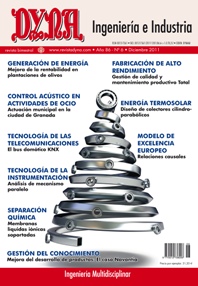ANALISIS DEL JUEGO, REPETIBILIDAD DEL POSICIONAMENTO Y PRECARGA DE UN MECANISMO PARALELO.
Palabras clave:
Mecanismo paralelo, juego, repetibilidad, actuador, rótula esférica, precarga, sistema de mediciResumen
Debido a la complejidad existente en el desarrollo de los modelos matemáticos de los mecanismos paralelos, es necesario realizar un análisis previo de los errores característicos del sistema. En este trabajo se determina el juego y la repetibilidad de posicionamiento de un mecanismo paralelo de dos grados de libertad giratorios, y se analiza la precarga necesaria para aumentar la precisión del sistema. Inicialmente se revisa la bibliografía especializada en el diseño y caracterización de mecanismos basados en cinemática paralela. En la mayoría de los estudios analizados, los errores como el juego son absorbidos por el modelo matemático sin caracterizar los componentes ni analizar cuáles de los errores del sistema son los más determinantes. Posteriormente se presenta la metodología utilizada para la caracterización de los componentes del sistema de posicionamiento. Para ello, se describen los procedimientos y los utillajes utilizados para cada equipo de medida y se comparan los diferentes sistemas de medición utilizados como sensores ópticos lineales, interferómetro láser y palpadores inductivos. Los resultados obtenidos muestran errores de juego del actuador en torno a los 45 m con una desviación del error de 3 m. La aplicación de una precarga a contracción sobre la rótula esférica permite obtener un juego menor de 3 m y, de esta manera, mejorar la precisión del sistema de posicionamiento. Finalmente se ha caracterizado el mecanismo paralelo de dos grados de libertad, diseñado para aplicaciones de metrología y procesos de máquina- herramienta, utilizando una máquina de medir por coordenadas. La caracterización desarrollada del mecanismo permitirá determinar los parámetros geométricos en la fase de calibración del mismo, así como desarrollar, posteriormente, procedimientos de corrección en función de la precarga necesaria para aumentar la precisión del sistema.Descargas
Publicado
2011-12-26
Número
Sección
ARTICULOS

